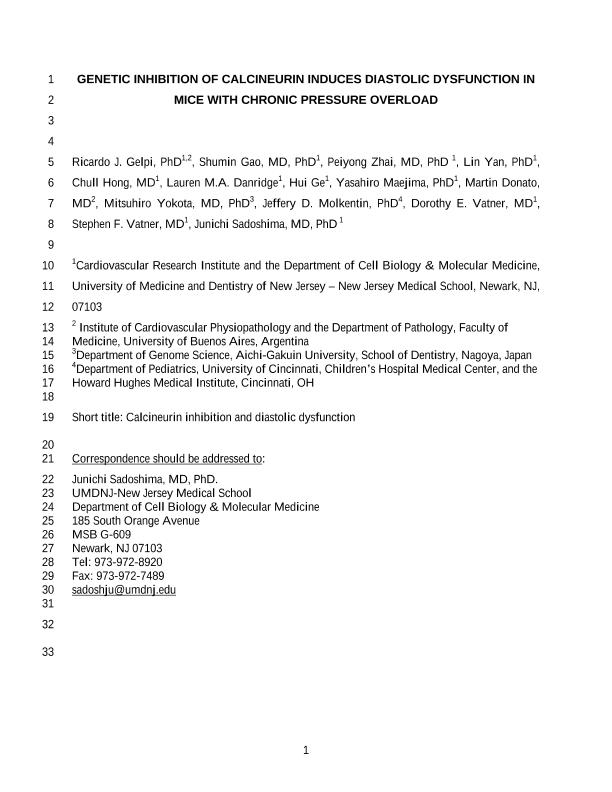Mostrar el registro sencillo del ítem
dc.contributor.author
Gelpi, Ricardo Jorge

dc.contributor.author
Gao, Shumin
dc.contributor.author
Zhai, Peiyong
dc.contributor.author
Yan, Lin
dc.contributor.author
Hong, Chull
dc.contributor.author
Danridge, Lauren M. A.
dc.contributor.author
Ge, Hui
dc.contributor.author
Maejima, Yasahiro
dc.contributor.author
Donato, Martin Alejandro

dc.contributor.author
Yokota, Mitsuhiro
dc.contributor.author
Molkentin, Jeffery D.
dc.contributor.author
Vatner, Dorothy E.
dc.contributor.author
Vatner, Stephen F.
dc.contributor.author
Sadoshima, Junichi

dc.date.available
2020-04-14T20:38:00Z
dc.date.issued
2009-11
dc.identifier.citation
Gelpi, Ricardo Jorge; Gao, Shumin; Zhai, Peiyong; Yan, Lin; Hong, Chull; et al.; Genetic inhibition of calcineurin induces diastolic dysfunction in mice with chronic pressure overload; American Physiological Society; American Journal of Physiology - Heart and Circulatory Physiology; 297; 5; 11-2009; 1814-1819
dc.identifier.issn
0363-6135
dc.identifier.uri
http://hdl.handle.net/11336/102556
dc.description.abstract
Genetic inhibition of calcineurin induces diastolic dysfunction in mice with chronic pressure overload. Am J Physiol Heart Circ Physiol 297: H1814 –H1819, 2009. First published August 28, 2009; doi:10.1152/ajpheart.00449.2009.—Calcineurin is a Ca2 /calmodulin-dependent protein phosphatase that induces myocardial growth in response to several physiological and pathological stimuli. Calcineurin inhibition, induced either via cyclosporine or genetically, can decrease myocardial hypertrophy secondary to pressure overload without affecting left ventricular (LV) systolic function. Since hypertrophy can also affect LV diastolic function, the goal of this study was to examine the effects of chronic pressure overload (2 wk aortic banding) in transgenic (Tg) mice overexpressing Zaki-4 (TgZ), a specific endogenous inhibitor of calcineurin, on LV diastolic function. As expected, in the TgZ mice with calcineurin inhibitor overexpression, aortic banding reduced the degree of LV hypertrophy, as assessed by LV weight-to-body weight ratio (3.5 0.1) compared with that in non-Tg mice (4.6 0.2). LV systolic function remained compensated in both groups with pressure overload. However, the LV end-diastolic stress-to-LV end-diastolic dimension ratio, an index of diastolic stiffness and LV pressure half-time and isovolumic relaxation time, two indexes of isovolumic relaxation, increased significantly more in TgZ mice with aortic banding. Protein levels of phosphorylated phospholamban (PS16), sarco(endo)plasmic reticulum Ca2 -ATPase 2a, phosphorylated ryanodine receptor, and the Na /Ca2 exchanger were also reduced significantly (P 0.05) in the banded TgZ mice. As expected, genetic calcineurin inhibition inhibited the development of LV hypertrophy with chronic pressure overload but also induced LV diastolic dysfunction, as reflected by both impaired isovolumic relaxation and increased myocardial stiffness. Thus genetic calcineurin inhibition reveals a new mechanism regulating LV diastolic function.
dc.format
application/pdf
dc.language.iso
eng
dc.publisher
American Physiological Society

dc.rights
info:eu-repo/semantics/openAccess
dc.rights.uri
https://creativecommons.org/licenses/by-nc-sa/2.5/ar/
dc.subject
hypertrophy
dc.subject
Diastole
dc.subject
Hemodynamics
dc.subject.classification
Sistemas Cardíaco y Cardiovascular

dc.subject.classification
Medicina Clínica

dc.subject.classification
CIENCIAS MÉDICAS Y DE LA SALUD

dc.title
Genetic inhibition of calcineurin induces diastolic dysfunction in mice with chronic pressure overload
dc.type
info:eu-repo/semantics/article
dc.type
info:ar-repo/semantics/artículo
dc.type
info:eu-repo/semantics/publishedVersion
dc.date.updated
2020-04-14T13:36:54Z
dc.journal.volume
297
dc.journal.number
5
dc.journal.pagination
1814-1819
dc.journal.pais
Estados Unidos

dc.journal.ciudad
Bethesda
dc.description.fil
Fil: Gelpi, Ricardo Jorge. Consejo Nacional de Investigaciones Científicas y Técnicas; Argentina. Universidad de Buenos Aires. Facultad de Medicina. Instituto de Fisiopatología Cardiovascular; Argentina. University of Medicine and Dentistry of New Jersey; Estados Unidos
dc.description.fil
Fil: Gao, Shumin. University of Medicine and Dentistry of New Jersey; Estados Unidos
dc.description.fil
Fil: Zhai, Peiyong. University of Medicine and Dentistry of New Jersey; Estados Unidos
dc.description.fil
Fil: Yan, Lin. University of Medicine and Dentistry of New Jersey; Estados Unidos
dc.description.fil
Fil: Hong, Chull. University of Medicine and Dentistry of New Jersey; Estados Unidos
dc.description.fil
Fil: Danridge, Lauren M. A.. University of Medicine and Dentistry of New Jersey; Estados Unidos
dc.description.fil
Fil: Ge, Hui. University of Medicine and Dentistry of New Jersey; Estados Unidos
dc.description.fil
Fil: Maejima, Yasahiro. University of Medicine and Dentistry of New Jersey; Estados Unidos
dc.description.fil
Fil: Donato, Martin Alejandro. Universidad de Buenos Aires. Facultad de Medicina. Instituto de Fisiopatología Cardiovascular; Argentina. Consejo Nacional de Investigaciones Científicas y Técnicas; Argentina
dc.description.fil
Fil: Yokota, Mitsuhiro. Aichi Gakuin University; Japón
dc.description.fil
Fil: Molkentin, Jeffery D.. University of Cincinnati; Estados Unidos
dc.description.fil
Fil: Vatner, Dorothy E.. University of Medicine and Dentistry of New Jersey; Estados Unidos
dc.description.fil
Fil: Vatner, Stephen F.. University of Medicine and Dentistry of New Jersey; Estados Unidos
dc.description.fil
Fil: Sadoshima, Junichi. University of Medicine and Dentistry of New Jersey; Estados Unidos
dc.journal.title
American Journal of Physiology - Heart and Circulatory Physiology

dc.relation.alternativeid
info:eu-repo/semantics/altIdentifier/doi/https://doi.org/10.1152/ajpheart.00449.2009
dc.relation.alternativeid
info:eu-repo/semantics/altIdentifier/url/https://journals.physiology.org/doi/full/10.1152/ajpheart.00449.2009
Archivos asociados
